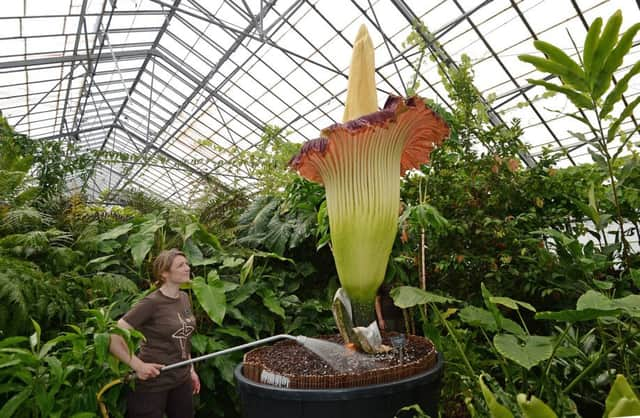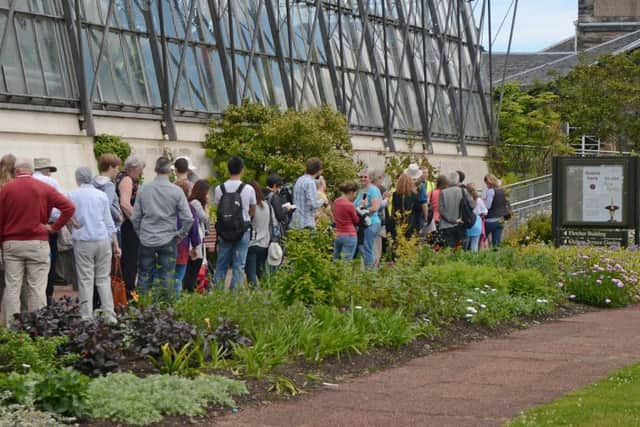Ashley Davies: Scotland’s botanical superstar


Every now and then, nature – albeit often flicked by the fat finger of man – presents us with a phenomenon that captures our imaginations and dominates conversation for a few odd and fascinating days.
Last year it was the 50ft sperm whale that washed up on Portobello beach. Heartbroken and horrified, some people weren’t sure whether it was ghoulish to go look at it, while others made a deliberate journey to witness the poor thing – all 26 tonnes of it – being winched on to a truck. As it was driven off to be buried at a landfill site in Fife, thousands of road-users were taken aback to see its enormous tail flopped tragically over the back of the vehicle, belying its oceanic grace and splendour in life.
Advertisement
Hide AdAdvertisement
Hide AdIn late 2011 and beyond it was the arrival of Tian Tian and Yang Guang, Edinburgh Zoo’s borrowed giant pandas. Edinburgh went panda mad; it still is, in fact, particularly whenever Tian Tian’s reproductive cycle comes under scrutiny. Nearly everyone remembers the day on which they arrived.


But as far as I can remember, we’ve never gone doolally over a plant. Or at least we hadn’t until Amorphophallus titanum swaggered on to the scene like Elvis, the Pope and Audrey II from Little Shop of Horrors all wrapped up in one massive, malodorous tropical package. While the history and properties of a 2.5-metre plant that only blooms for a few days are fascinating in themselves, it’s been joyous watching people get excited about it – particularly those who would never consider themselves fans of botany.
Over the last weekend alone more than 4,000 people queued patiently at the Royal Botanic Garden of Edinburgh and handed over a fiver for the privileged glimpse at the smelly, rare giant that blooms once in about 12 years and is known affectionately as the “corpse plant”.In case you missed all this, the Amorphophallus titanum, Latin for “giant, misshapen penis” (not big on subtlety, those early gentleman plant-namers; one imagines their conventions involved a lot of pointing, wet-nosed sniggering and utterings in classical languages of “boobs!”, “willy!” and “snot!”) is supposed to be the smelliest plant in the world. Its natural habitat is in the jungles of Sumatra (now threatened by logging and oil palm plantations), and when it flowers it kicks out a stench that initially smells like rotten flesh, attracting the kind of insects that can’t get enough of that stink – carrion beetles and sweat bees. They fly into the spadix, treat it as a luxurious, humid honeymoon suite, then scarper when they realise there isn’t any scrumptious putrid meat after all, taking nature’s goodies with them to pollinate the next plant.
The growth of the new plant happens very slowly, and then very very fast. After seeing not much action for many years, the experts at the Botanics had a feeling it might be about to flower when a new shoot appeared in May. Soon it was growing at 15cm a day (which is probably the same rate at which Wimbledon hopeful Nick Kyrgios shot up during puberty) and on 12 June a flower started peeking out into the balmy, welcoming atmosphere of the glasshouse in genteel Inverleith.
And boom – the marketing machine sprung into action. The plant was nicknamed New Reekie and confidently given a hashtag ahead of the social media explosion; easily digestible information booklets were put out and the press briefed. Personnel were put on alert and nearly everyone – staff and volunteers – offered to come in to lend a hand over the big weekend. This was their Glastonbury, though with better lavatories and no discernible narcotics.
Like a bunch of teenagers who’ve just finished their exams and received their pocket money, New Reekie’s smell peaked on Friday night, and by Saturday morning hundreds and then thousands of eager folk were preparing to queue to see it.
I went on Sunday afternoon, by which time the queue was an hour and a half long, and a fascinating study in itself. Some came with their families – often three generations – and some came alone. People were polite, excited and friendly. I’d hazard a guess that vegetarians and members of the teaching profession were pretty well represented.
As the queue snaked slowly in the sun, infectiously enthusiastic staff would come over and share snippets of information, patiently answering questions they must’ve been asked thousands of times. At one point during the queue we got to see a time-lapse film of the plant’s growth, and children were invited to sit down and draw it, while adults worked on watercolours of the beast. When we finally got into the glasshouse it was honestly quite hard to tell what it smelt like. To me it was a bit like badly cured leather or faraway rotten fish – no more offensive than what you might encounter in a male-dominated newspaper office on election night. It was also quite hard to isolate the smell of New Reekie in that humid atmosphere of tropical plants and warm bodies.
Advertisement
Hide AdAdvertisement
Hide AdWhat was extraordinary was the size of it, and the sheer magnificence of it, particularly given the brevity of its bloom. The spathe leaves looked like the upside-down skirt into which a plumb celeb had been stuffed for an early, unsuccessful round on Strictly Come Dancing, pale green, tight and ruffled around the rump with dark red frills at the hem. The light yellow spadix thrust up aggressively towards the ceiling, and the whole thing felt very much alive – so much so that it inspired a friend’s son to dream up a comic-book story, investing the plant with a personality which, had you seen it up close, makes perfect sense. He can’t have been the only one.
By the time you read this, New Reekie may well have collapsed. Our celebrity plant, our destination botanical feature, will be dried and kept as a specimen.
On an average day in June, the Botanics glasshouse attracts between 200 and 250 people, but over just a few days in late June around 15,000 people came along, and many of those signed up to become “friends”. It’s unlikely any of those will forget that day. Who’d have thought one plant could have caused such a stink?